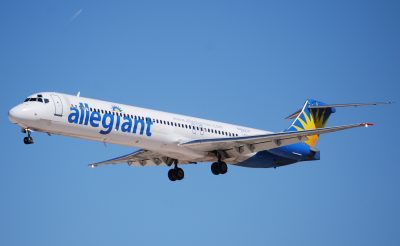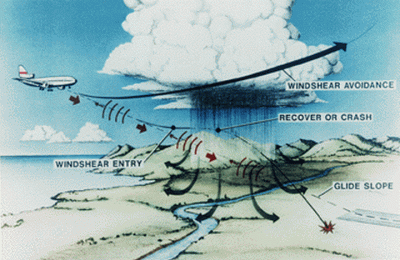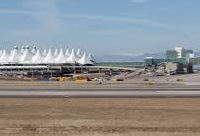
Wind shear in Denver. It was the first day of summer, June 21, 2018. I was enroute to Denver on Allegiant Flight 1320. Aside from an initial delay in loading the aircraft, due to having too many ticketed passengers, the flight had been uneventful. That all changed on final approach.

We approached Denver International Airport around 5:00pm MDT. It was fairly clear outside with some haze and clouds over the Front Range of the Rockies in the distance. As we descended on final approach, I looked out the window to the left. I saw another airliner in a steep climb. Moments later, I felt our nose rising and the power coming in abruptly on our own aircraft. Before most passengers knew it, we were in a steep climb. WIND SHEAR was my first thought.
What is Wind Shear?
In all of my years of piloting, wind shear was one of the few phenomenon that I feared. The main reason for that fear is that the pilot has no control over wind shear. “Wind shear is a change in wind speed and/or direction over a short distance,” as defined by the FAA. Wind shear can take many forms, but the most concerning for pilots is when a headwind on final approach becomes no wind, or worse yet, a tailwind. The Federal Aviation Administration (FAA) had published an excellent white paper on the subject: https://www.faasafety.gov/files/gslac/library/documents/2011/Aug/56407/FAA%20P-8740-40%20WindShear%5Bhi-res%5D%20branded.pdf
Wind shear is discussed in detail in Session 14 of Doctor Aviation (https://doctoraviation.com/about/). However, for a quick primer, below is a picture of wind shear. In the diagram, the airliner is approaching the runway on the right side of the picture. Initially the aircraft is experiencing a headwind. Suppose the headwind is 20 knots. This will help the aircraft keep its desired approach speed of 150 knots. However, as the aircraft goes forward and descends, suddenly a 20 know tailwind can be experienced. Now the airspeed will suddenly drop from 150 knots to 110 knots, which can cause a stall and crash. See the equations below the diagram.

Equation 1: Approach Speed is 150 knots. 130 knots (from the engines) + 20 knots (from the headwind)
Equation 2: Approach Speed is now 110 knots. 130 knots (from the engines) – 20 knots (from the tailwind)
Meanwhile, On the Flight
Back to my flight on June 21. As we climbed out and away from our initial approach, I could tell the lady next to me was very nervous. I shared with her that I was a retired Air Force pilot and that we had likely experienced wind shear. I gave her a very tame explanation of wind shear and told her that honestly, my confidence in the aircrew was increased due to their quick and proper reaction to the situation.

Denver, in particular, in susceptible to wind shear due to its location on a plain. The mountains rise, suddenly, and sharply to the west.
The flight attendant announced that the captain had seen fit to discontinue the approach and that we would be going around for another approach. The captain would inform us of the situation, time permitting. He never came over the intercom.

After we landed the lady next to me shared that she didn’t particularly like flying to begin with. So she thanked me for my explanation, which had helped to calm her. I waited until all the passengers had deplaned and then approached the pilot at the front of the cabin.
I explained that I was a long time pilot. “So did we get some wind shear on final,” I asked. He looked surprised.
He perked up and told me that the two planes in front of us had also gone around. I mentioned that plane I saw on approach to the parallel runway to our left was also going around.
We talked about some of the warning signals the pilot now has. In this case, he received a verbal signal to pull up. Prior to about 20 years ago, the only indication of wind shear was a sudden drop (or rise) in airspeed. We have made strides in our aviation safety.
I asked, how high the wind shear had occurred. He told me about 800 AGL (800 feet above ground level). I commended him for a job well done.
I maybe experienced wind shear once or twice in my flying career and once before while flying commercial, I would be happy to never encounter it again, but it is a reality of flying.
Ironically I flew with this same pilot on the way back from Denver the next Sunday. We experienced over half an hour of moderate turbulence at altitude on that flight. The most I had ever experienced. When I talked with the pilot after the second flight, he suggested maybe we should not fly together again due to our affinity for weird weather phenomenon.
